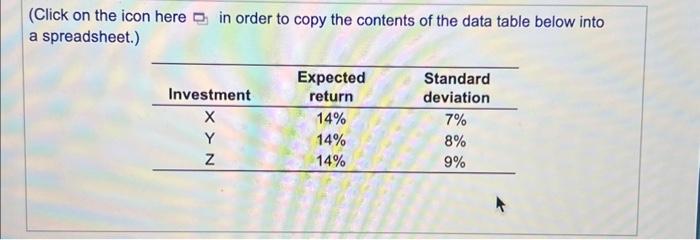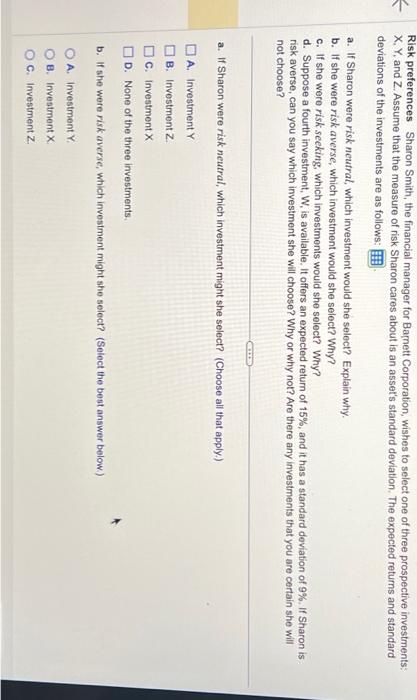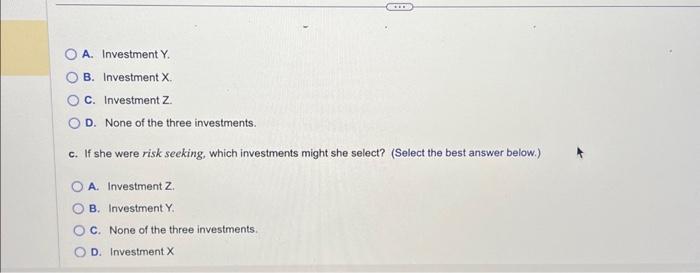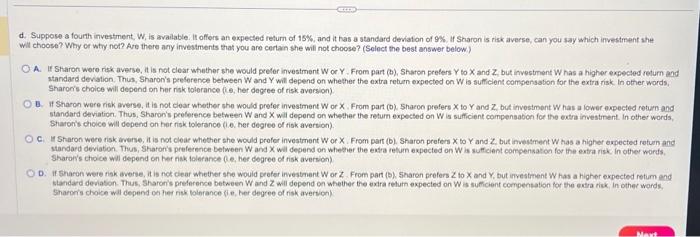a spreadsheet.) Risk preferences Sharon Smith, the financial manager for Bamnett Corporation, wishes to select one of three prospective investments: X,Y, and Z. Assume that the measure of risk Sharon cares about is an asset's standard deviation. The expected returns and standard deviations of the investments are as follows: a. If Sharon were risk neutral, which investment would she select? Explain why. b. If she were risk averse, which investment would she select? Why? c. If she were risk seeking, which investments would she select? Why? d. Suppose a fourth investment, W, is available. It offers an expected return of 15%, and it has a standard deviation of 9%. If Sharon is risk averse, can you say which investment she will choose? Why or why not? Are there any investments that you are certain she will not choose? a. If Sharon were risk neutral, which investment might she select? (Choose all that apply.) A. Investment Y B. Investment Z. C. Investment X D. None of the three investments. b. If she were risk averse, which investment might she select? (Select the best answer below.) A. Investment Y. B. Investment X. c. Investment Z. A. Investment Y. B. Investment X. C. Investment Z. D. None of the three investments. c. If she were risk seeking, which investments might she select? (Select the best answer below.) A. Investment Z. B. InvestmentY. C. None of the three investments. D. Investment X d. Suppose a fourth investment, W, is svailable. It offors an expected retum of 15%, and it has a standard deviaton of 9%. If Sharon is risk averse, can you say which investrnent she Wit choose? Why or why not? Ave there ary investments that you are certan she wili not choose? (Seloct the best answer below). A. If Sharon were rek averse, it is not cleat whether she would prefer investment W or Y. From part (b), Sharon prefers Y to X and Z, but investment W has a higher expected return and standard devation. Thus, Sharon's prelorence between W and Y will depend on whether the extra retuen expected on W is sutficient compensabion tor the extra risk in other words. Sharori's choice will depend on her risk tolerance (te, her degree of risk aversion) B. If Sharon were nisk averse, it is not clear whether she would prefer investment W or X. From part (b) 5 aharon prefers X to Y and Z, but itvestment W has a fower expected return and standard deviation. Thus, Sharon's peoterence between W and X will depend on whether the return expected on W is sufficient compensabon for the extai investrent. In other words, Sharon's choice will depend on her risk tolerance (l.e. her degreo of tisk aversion). c. It Sharon were risk averse, it is not clear whether she would profor investment W or X. From parr (b). Sharon prefens X to Y and Z, but inveitment W has a higher expected retum and standard deviation. Thus, Sharon's preference between W and x wil depend on whetier the exita relum expected on W is sumicient compensation for the extra risk in other words. Sharof's choice wil depend on her nak tolerance (ie, her degree of risk aversion) D. If sharon were riak averee, It is not ciear whether she would preter investment W or Z. From part (D) sharon prefers Z to X and Y, but ivestment W has a higher expected retim and standard deviasion. Thus, Sharon's preference between W and z will depend on whether the exira retuth expected on W is sufficient compentation for the extra tikk, in other wards. Sharoris choke wal depend of her risk loilerance \{f e, her degree of risk avervon)










